Click on image for larger view
23 species, 52 mineral photos. See also: Mindat.org locality link
The Ruggles Mine, a New Hampshire tourist destination for decades, was closed in 2016. The 235 acre property was purchased in 2019 by a pair of New York investors. Per a NHPR web article, the new owners "plan on doing a major upgrade and open it back up again as a tourist attraction. The new owners have also been talking with local and regional colleges to get them involved for geology studies at Ruggles. But before re-opening, the new owners will need to do some maintenance work and getting approvals necessary for the planned expansions." The new owners hosted a "meet and greet" at the mine on August 8, 2020 to discuss their vision for the mine. From the viewpoint of the mineral collecting community, this vision is most promising. The investment to return the mine to a tourist attraction will be substantial.
Phillip Morrill in his New Hampshire Mines and Mineral Localities booklet (1960), lists the following species for Ruggles:
(invalid names, discredited species, discredited Ruggles occurrence (per mindat.org), and varietal names eliminated. Bold have photos here.)
albite, apatite/fluorapatite, autunite/meta3, bertrandite, beryl, beta-uranophane2, biotite group (as lepidomelane), chrysoberyl, graftonite6, "gummite", kasolite1, marcasite1, muscovite6, montmorillonite, parsonsite, phosphuranylite, quartz, soddyite, torbernite/meta3,6, triphylite, uraninite, uranophane2, vandendriesscheite, vivianite, zircon.
Mindat.org (2020) adds the following species: almandine, anglesite1, bismuth1, columbite-(Fe), fourmarierite ?, galena1, goethite1, löllingite, microcline1, paulscherrerite4 - (dehydrated schoepite - mineral occurs as a powdery replacement product)5, pyrite, pyrrhotite1, sillimanite, staurolite
The Harvard Museum catalog adds the following species: clarkeite6 (discredited), moraesite6, schorl6, wolfeite6.
The Yale-Peabody Museum catalog adds: renardite, a lead-uranium-phosphate. Renardite is not a currently approved IMA species. Ruggles occurrence not confirmed.
I [tm] have added (with cautionary note) beraunite, laueite, strunzite, from a purchased specimen that are reasonable Ruggles species, given the presence of triphylite, but without additional examples, may be viewed as a suspect locality attribution.
A Mineral News article, vol. 37, no. 4, April, 2021, by Fred Davis, "The Discovery of Radioactive Minerals at Ruggles mine, Grafton, New Hampshire" provides a very comprehensive discussion of RA minerals from Ruggles. The article has an extensive bibliography.
-------------------------------
Notes:
1Most of the reported species that I have not seen were reported by Gunar Bjareby (1965): Fifty Years of Mineral Collecting, Part 7, Rocks & Minerals: 40: 491-493.
2 Uranophane and beta-uranophane are dimorphs, (chemically identical), and both belong to the same monoclinic class. I am unaware of any way short of XRD to differentiate these two species.
3Autunite, meta-autunite and torbernite, metatorbernite differ only in the amount of water content - the meta species has four fewer water molecules. A bit of dehydration is unlikely to be determined by collectors, so I group them together. Generally, these species lose water (dry out) when exposed to atmospheric conditions. The brighter yellow-green of autunite and emerald green of torbernite fades with time. Avoid high temperature lighting when photographing these species.
4Paulscherrerite is dehydrated schoepite. The mindat.org American Mineralogist reference implies that it may be found at Ruggles, but a proven example is lacking.
5 Korzeb et al. (1997) identified “dehydrated schoepite” as an early product of uraninite weathering in the Ruggles and Palermo granitic pegmatites, New Hampshire. [tm] Not exactly a confirmation for paulscherrerite !
6 The Harvard Museum catalog indicates they have one or more specimens of this species.
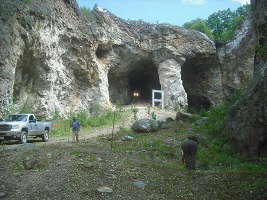
Locality: Ruggles Mine, Grafton, NH
Photographer: Tom Mortimer
Notes: Vehicle headlights entering main pit.
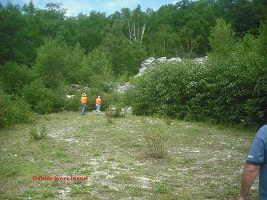
Locality: Ruggles Mine, Grafton, NH
Photographer: Tom Mortimer
Notes: Much of the lower dump is overgrown.
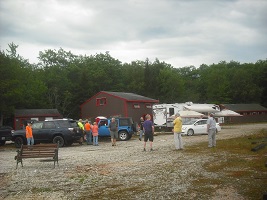
Locality: Ruggles Mine, Grafton, NH
Photographer: Tom Mortimer
Notes: The new owners hosted a "meet and greet" at the mine August 8, 2020, (social distancing mostly observed).
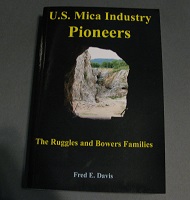
Author: Fred Davis
Notes: "US Mica Industry Pioneers" by Fred Davis, 2013. 445 pages. Thoroughly researched and extensively illustrated history of US mica mining.
Includes 120 pages of references, a "Persons" index, and a subjects index.
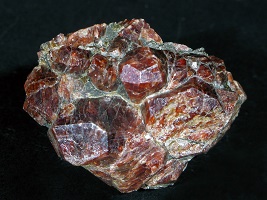
Locality: Ruggles Mine, Grafton, NH
Specimen Size: 4.5 cm specimen with almandine garnet crystals to 1.5 cm
Field Collected: Unknown - a purchased specimen
Catalog No.: 2054
Notes:
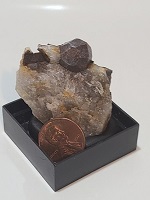
Locality: Ruggles Mine, Grafton, NH
Specimen Size: 3.6 cm specimen
Field Collected: Matt Butler - 2024
Catalog No.: A Matt Butler specimen and photo.
Notes: [tm] Undoubtedly nice garnets are present at Ruggles, but photos of them are rare. This is a very nice single isolated crystal.
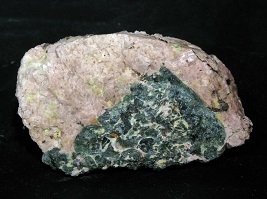
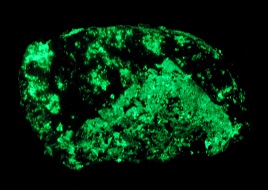
Locality: Ruggles Mine, Grafton, NH
Specimen Size: 5 cm specimen with blue-green apatite in feldspar matrix
Field Collected: Sarah Bagley - Tom Mortimer - Aug., 2020
Catalog No.: NC
Notes: There is a LOT of autunite intermixed in this specimen. I was surprised to see the apatite area fluoresce bright green. I broke off a several mm piece and crushed it between glass plates. Much of the crushed grains also fluoresces, but not all. I concluded that the autunite is intimately intermixed with the apatite and feldspar. The autunite presence overwhelms the yellow fluorescence of apatite. A yellow apatite fluorescence was observed on another blue-green apatite sample.
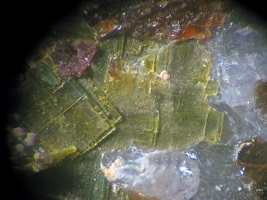
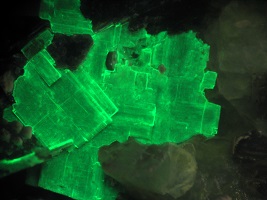
Locality: Ruggles Mine, Grafton, NH
Specimen Size: 1.5 mm autunite plate group, daylight & SW UV photos
Field Collected: Harvard research
Catalog No.: NC
Notes:
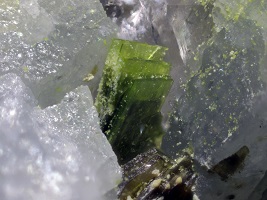
Locality: Ruggles Mine, Grafton, NH
Specimen Size: 1.2 mm autunite plate group
Field Collected: Harvard research
Catalog No.: u2374
Notes:
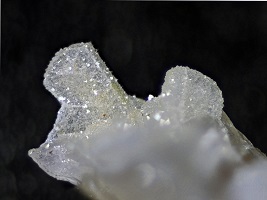
Locality: Ruggles Mine, Grafton, NH
Specimen Size: 8 mm field of view. 2.5 mm bertrandite crystals overgrown with micro quartz crystals.
Field Collected: Dana Jewel
Catalog No.: u1961
Notes:
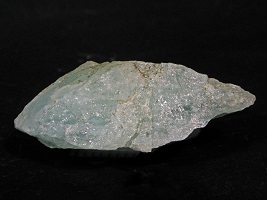
Locality: Ruggles Mine, Grafton, NH
Specimen Size: 4.5 x 2.5 cm glassy beryl sample.
Field Collected: Tom Mortimer
Catalog No.: NC
Notes: I picked this chunk off the quarry floor during my Aug. 8, 2020 visit. Recent rain likely aided me in spotting it. If the number of beryl crystal photos on mindat.org (one, minID HCU-R61) are an indication, nice beryl crystals are uncommon at Ruggles, despite hoards of collectors crawling over the property for decades.
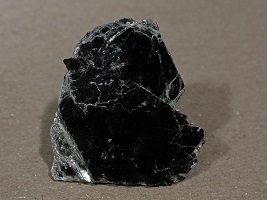
Locality: Ruggles Mine, Grafton, NH
Specimen Size: 4 cm sample.
Field Collected: Tom Mortimer
Catalog No.: NC
Notes: A voucher specimen for biotite (mica group) at the Ruggles Mine. Biotite is common here. I picked this chunk off the quarry floor during my Aug. 8, 2020 visit.
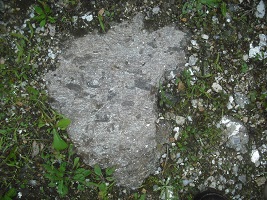
Locality: Ruggles Mine, Grafton, NH
Specimen Size: Approx. one foot rock in mine floor
Field Collected: Remains in mine floor. Photo August, 2020
Notes: [tm] When I spotted this on the quarry floor, I thought staurolite. Staurolite is reported at Ruggles. On a Sept 2021 visit to Ruggles, I whacked off a piece and brought home. A close examination indicated this is a dark-brown tourmaline, most likely dravite. See analysis result, next photo.
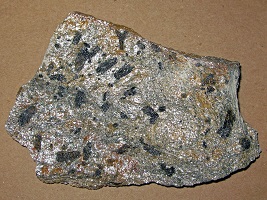
Locality: Ruggles Mine, Grafton, NH
Specimen Size: 5.5 inch specimen
Field Collected: Tom Mortimer
Notes: On a September 2021 visit to Ruggles Mine (with permision), I whacked off a chunk of this from the quarry floor. A polished grain EDS analysis indicated a tourmaline mineral almost exactly at the dravite-schorl midpoint, just slightly on the dravite side.
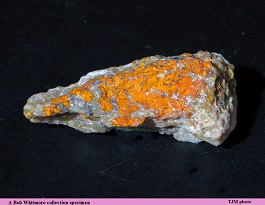
·4H2O Locality: Ruggles Mine, Grafton, NH
Specimen Size: 3.2 cm specimen
Field Collected: John Reiner?
Catalog No.: A Bob Whitmore specimen ex. John Reiner #4448
Notes: Fourmarierite has appeared on a number of earlier New Hampshire mineral species lists. However, per Frondel, C., 1956, Mineral Composition of Gummite, Am Min. V. 41 539-568: "Fourmarierite was doubtfully identified as a minor constituent of gummite from a number of localities, including .... the Palermo and Ruggles pegmatites in New Hampshire."
A more recent article by Korzeb, Foord, and Lichte, The center evolution and paragenesis of uranium minerals from the Ruggles and Palermo granitic pegmatites, New Hampshire, Canadian Mineralogist, Vol. 35, pp. 135-144 (1997), expands on Frondel's paper and does not mention formarierite in the paragenesis of uranimum minerals at the subject localities.
This ex. John Reiner specimen is likely typical of historical NH specimens labeled as fourmarierite. Its appearance matches Mineral 'A' described in the Korzeb et. al. article: as "the common component of orange gummite", composition: (UO2)(OH)4 · 1/2H2O + 2H+(aq)
Finally, I (TM) would like to note how difficult it is to eliminate discredited species occurrences once they have appeared in the literature. Art Smith's article, New Hampshire Mineral Locality Index, included in Vol. 80 pp. 242-261 (2005), Rocks and Minerals, lists formarierite as occurring at the Ruggles Mine.
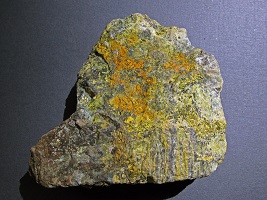
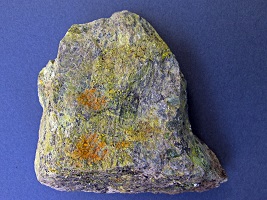
Locality: Ruggles Mine, Grafton, NH
Specimen Size: 11 cm specimen, front & back
Field Collected: Tom Mortimer - Aug. 2020
Catalog No.: NC
Notes: "Gummite", (the orange and yellow here) is not a mineral species, but a mixture of uraninite and secondary uranium minerals of variable composition. It is generally considered a mixture of boltwoodite, clarkeite, curite, kasolite, soddyite, uraninite, and uranophane.
Daylight photos.
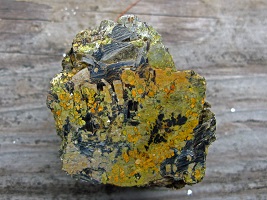
Locality: Ruggles Mine, Grafton, NH
Specimen Size: 6 cm polished surface gummite specimen
Field Collected: Bob Whitmore & Harvard research associates
Catalog No.: NC
Notes: Orange gummite with black uraninite. Specimen very "hot." Left outside and took daylight photo.
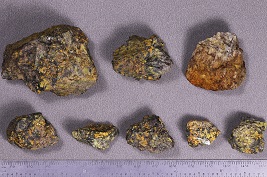
Locality: Ruggles Mine, Grafton, NH
Specimen Size: TN & larger. Scale for reference
Field Collected: Ruggles specimens collected by Fred Davis August 2020
Catalog No.: Fred Davis specimens
Notes: Orange-yellow gummite with black uraninite.
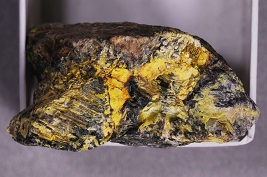
Locality: Ruggles Mine, Grafton, NH
Specimen Size: Miniature
Field Collected: Ruggles specimen collected by Fred Davis August 2020
Catalog No.: Fred Davis specimens
Notes: Yellow gummite with black uraninite.
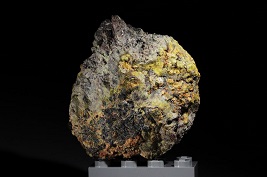
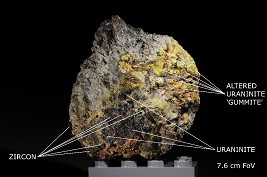
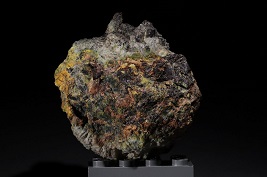
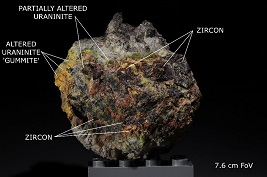
Locality: Ruggles Mine, Grafton, NH
Specimen Size: One LEGO brick
Field Collected: Ruggles specimen collected by Fred Davis August 2020
Catalog No.: Fred Davis specimens
Notes: Yellow gummite with black uraninite.
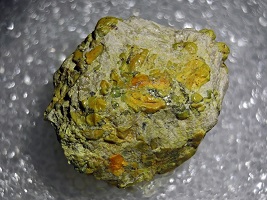
Locality: Ruggles Mine, Grafton, NH
Specimen Size: 1.6 cm specimen
Field Collected: Ex. Janet Cares specimen
Catalog No.: u2509
Notes: Purchased at a spring 2021 MMNE meeting auction. Janet Cares had this labeled "Soddyite." Kasolite, Pb(UO2)(SiO4)·2H2O , is suggested by polished grain EDS analyses . Kasolite is reported from the Ruggles Mine. Kasolite is the only U, Pb, Si, O mineral.
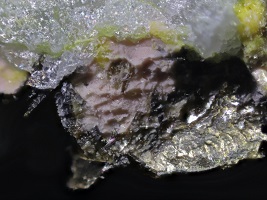
Locality: Ruggles Mine, Grafton, NH
Specimen Size: 3 mm field of view. Pink, soft (clay-like) montmorillonite
Field Collected: Bob Whitmore & Harvard research associates
Catalog No.: u2376
Notes: A voucher specimen for montmorillonite at Ruggles. Montmorillonite is listed for Ruggles.
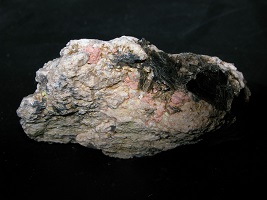
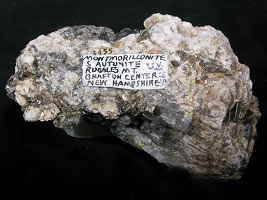
Locality: Ruggles Mine, Grafton, NH
Specimen Size: 9 cm specimen with pink, soft (clay-like) montmorillonite and black biotite
Field Collected: ex. Bob Whitmore
Catalog No.: 2137
Notes: Hand-written label has "1950" date.
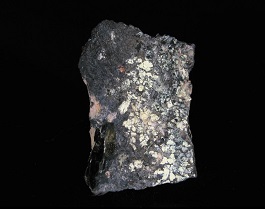
Locality: Ruggles Mine, Grafton, NH
Specimen Size: 3.7 cm specimen. Parsonsite is pale, earthy, yellow mineral
Field Collected: Bob Whitmore & Harvard research associates
Catalog No.: 1661
Notes: Identified by Bob Whitmore. Caution: sight ID of earthy uranium secondary minerals is problematic.
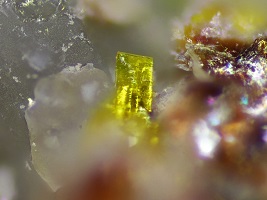
Locality: Ruggles Mine, Grafton, NH
Specimen Size: 0.4 mm flat, tabular, crystal
Field Collected: Bob Whitmore & Harvard research associates
Catalog No.: u2373
Notes: This specimen and several others came from a lot studied by Korzeb, Foord, & Lichte for their 1997 paper in Canadian Mineralogist (vol. 35, 135-144), "The Center Evolution and Paragenesis of Uranium Minerals from the Ruggles and Palermo Granitic Pegmatites, New Hampshire."
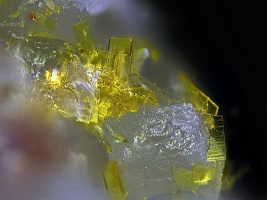
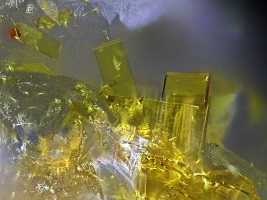
Locality: Ruggles Mine, Grafton, NH
Specimen Size: 1.3 mm field of view and 0.9 mm zoom view
Field Collected: Harvard research
Catalog No.: u2375
Notes: These small crystals have a thin rectangular bladed habit, typical for the species.
Used low temperature LED light source for these photos as I did not want to heat them in any way. Phosphuranylite contains a lot of water.
No, these do not fluoresce.
Differentiating phosphuranylite from uranophane (and uranophane-beta) visually is very risky. All three can present as orthorhombic appearing yellow crystals. EDS can easily resolve this, as phosphuranylite is a phosphate and uranophane (& beta) are silicates. Both uranophane and phosphuranylite are reported from Ruggles. These crystals are in thin seams in fluorapatite, a mineral containing both P and Ca, required for phosphuranylite. Testing planned.
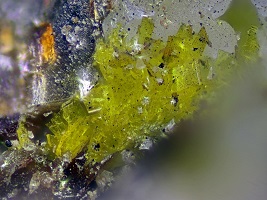
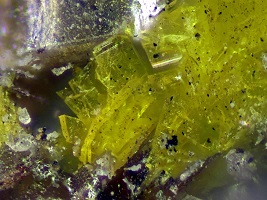
Locality: Ruggles Mine, Grafton, NH
Specimen Size: 1.1 mm field of view and zoom view of lower left area
Field Collected: Harvard research
Catalog No.: u2375
Notes: Lots of "crud" on these crystals, but reluctant to put in ultrasonic.
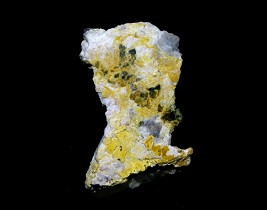
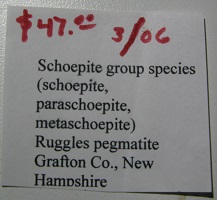
Locality: Ruggles Mine, Grafton, NH
Specimen Size: 2.5 cm specimen. Schoepite lemon yellow, with purchase label
Field Collected: Purchased from and identified by Alexander Falster, Department of Geology and Geophysics, University of New Orleans, LA.
Catalog No.: 1503
Notes:
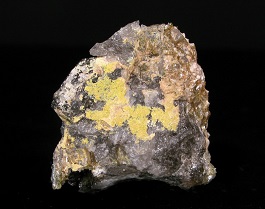
Locality: Ruggles Mine, Grafton, NH
Specimen Size: Yellow very fine acicular Soddyite crust on 3 cm specimen
Field Collected: Bob Whitmore & Harvard research associates
Catalog No.: 1678
Notes:
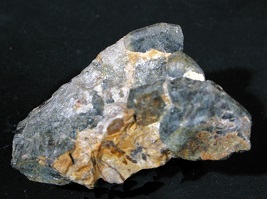
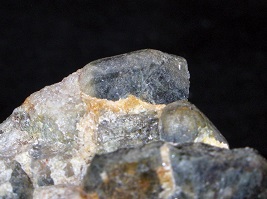
Locality: Ruggles Mine, Grafton, NH
Specimen Size: 4.7 cm specimen with 1.2 cm triphylite crystal, top. Zoom view is 2 cm.
Field Collected: Purchased specimen from D. Robenson Minerals. Ex. Johanson collection - 1942
Catalog No.: 1876
Notes: Phillip Morrill does report triphylite as occurring at the Ruggles Mine. Triphylite crystals have scaly flakes of fluorescent autunite on their surface. Uranium minerals such as autunite are common at the Ruggles Mine.
Specimen contains many broken triphylite crystals, but only one essentially complete one.
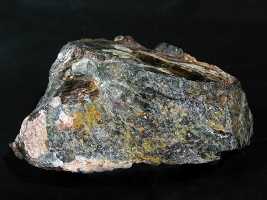
Locality: Ruggles Mine, Grafton, NH
Specimen Size: 5.5 cm specimen of massive triphylite.
Field Collected: Bob Whitmore & Harvard research associates
Catalog No.: NC
Notes: The brownish areas are likely an alteration to ferrisicklerite. A 5 mm uraninite crystal protrudes for the top of the specimen.
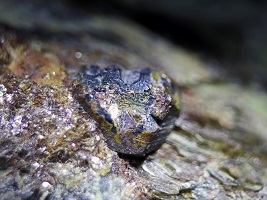
Locality: Ruggles Mine, Grafton, NH
Specimen Size: 5 mm uraninite crystal
Field Collected: Bob Whitmore & Harvard research associates
Catalog No.: NC
Notes: Euhedral, un-altered, uraninite crystals are uncommon at Ruggles based on the paucity of similar photos on mindat.org.
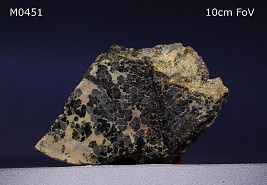
Locality: Ruggles Mine, Grafton, NH
Specimen Size: 6.5cm x 5cm x 1.5cm.
Field Collected: Fred Davis
Catalog No.: Fred Davis C0451
Notes: This polished side was used for making autoradiographs, popular in the 1940s and -50s.
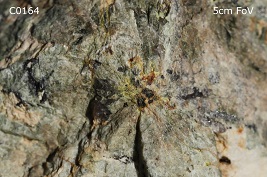
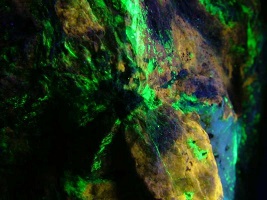
Locality: Ruggles Mine, Grafton, NH
Specimen Size: 5 cm field of view. Daylight and SW UV lighting
Field Collected: Fred Davis
Catalog No.: Fred Davis C0164
Notes: Massive fluorapatite with uraninite and secondaries (that follow the radial fractures from the uraninite in the apatite). This detail view reveals a cluster of uraninite crystals in the apatite with radial fractures. This is the uncommon occurrence described by Ben Shaub (1938) AmMin "Uraninite from Grafton Center, New Hampshire." Collected 2004.

Locality: Ruggles Mine, Grafton, NH
Specimen Size: 5 mm uraninite crystal
Field Collected: Bob Whitmore & Harvard research associates
Catalog No.: NC
Notes: Euhedral, un-altered, uraninite crystals are uncommon at Ruggles based on the paucity of similar photos on mindat.org.
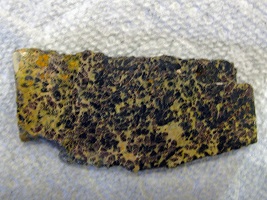
Locality: Ruggles Mine, Grafton, NH
Specimen Size: About a 3 inch slab with blebs of black uraninite
Field Collected: Unknown
Catalog No.: NC (Not Cataloged)
Notes: A gift from Anna Wilken (2/23) who was given it by Pat Barker. It is believed Pat acquired this slab from Bob Whitmore.
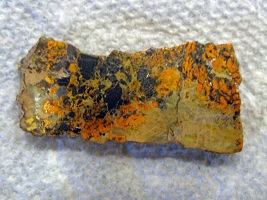
Locality: Ruggles Mine, Grafton, NH
Specimen Size: About a 2 inch slab with blebs of black uraninite and orange gummite secondaries
Field Collected: Unknown
Catalog No.: NC (Not Cataloged)
Notes: A gift from Anna Wilken (2/23) who was given it by Pat Barker. It is believed Pat acquired this slab from Bob Whitmore.
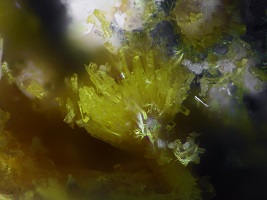
Locality: Ruggles Mine, Grafton, NH
Specimen Size: 0.4 mm uranophane spray
Field Collected: Harvard research
Catalog No.: u2377
Notes: The few scattered orthorhombic prisms are likely phosphuranylite.
Uranophane and uranophane-beta are chemically equivalent, monoclinic, dimorphs. Presently (2020) these are grouped together as uranophane.
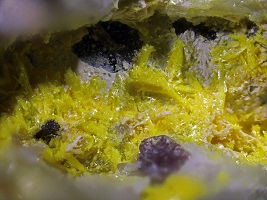
Locality: Ruggles Mine, Grafton, NH
Specimen Size: 4 mm field of view
Field Collected: Harvard research
Catalog No.: u2377
Notes:
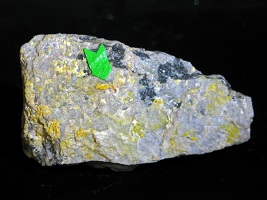
Locality: Ruggles Mine, Grafton, NH
Specimen Size: 4 cm specimen
Field Collected: Tom Mortimer - 9/17/21
Catalog No.: 2182
Notes: Yellow crust of uranophane on feldspar. Green arrow points to EDS sample point.
EDS analyses (BC562) indicated a chemistry of Ca1.0U4.6Si2.8O34.6 , normalized for one Ca. The uranium content is very high for uranophane, but still the best species fit. Small amounts of P, Al, Mn, Fe, and Pb suggest that other uranium secondary species may be mixed in.
Uranophane chemistry is Ca(UO2)2[SiO3(OH)]2 · 5H2O .
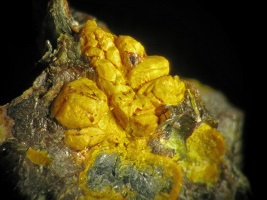
Locality: Ruggles Mine, Grafton, NH
Specimen Size: 6 mm field of view. Cluster of subhedral, orange-yellow, Vandendriesscheite crystals
Field Collected: Al Stevenson (August, 1968) A purchased specimen.
Catalog No.: u1236
Notes: ID by original field collector, Al Stevenson. Species is reported from the Ruggles Mine. Specimen color and luster are appropriate for vandendriesscheite. [tm]No other photos or specimens of Ruggles Mine vandendriesscheite are known to me.
There are several other intense yellow, secondary, uranium species reported from Ruggles. Many are components of "gummite." Differentiating these species is difficult.
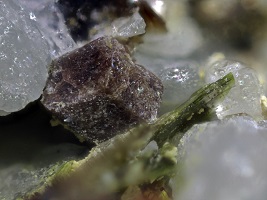
Locality: Ruggles Mine, Grafton, NH
Specimen Size: 1.5 mm zircon crystal
Field Collected: Harvard research
Catalog No.: u2377
Notes: Edge-view greenish autunite plate to lower right of zircon crystal.
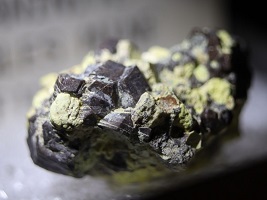
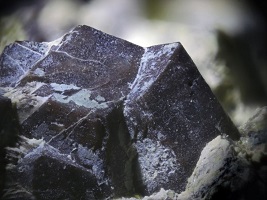
Locality: Ruggles Mine, Grafton, NH
Specimen Size: 1.8 cm specimen
Field Collected: From the Janet Cares collection. Fred Davis specimen from 2020 MMNE auction
Catalog No.: A Fred Davis specimen
Notes: Janet had this specimen labeled uraninite
A three inch specimen purchased at the Gilsum Swap, June 2008, ($5.00) contained a number of micro phosphate minerals. Several phosphate minerals are listed for Ruggles (mindat.org and Phillip Morrill), including triphylite, vivianite, and graftonite, but laueite, strunzite, and beraunite are not. One has to be suspect of purchased specimens of uncommon minerals from a locality, particularly when no other examples exist. Laueite, strunzite, and beraunite are alterations of triphylite seen at several other NH localities. Multiple examples of triphylite are known from Ruggles, (two here). However, there is no substitute for the certainty of self-collected examples of the less common phosphate species.
I would like to hear from any collector that has well documented secondary phosphate specimens from the Ruggles Mine.
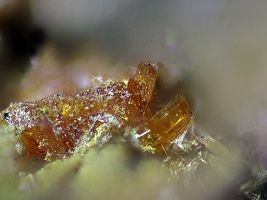
Locality: Ruggles Mine, Grafton, NH
Specimen Size: 0.9 mm field of view. A bit of strunzite is also present.
Field Collected: Unknown
Catalog No.: u775
Notes:
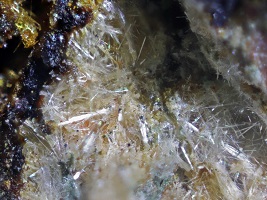
Locality: Ruggles Mine, Grafton, NH
Specimen Size: 2 mm field of view
Field Collected: Unknown
Catalog No.: u963
Notes: